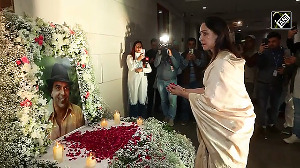The word 'recession' is being frequently used in India in recent months despite the fact that the economy continues to grow and that even at 7 per cent in the current fiscal and perhaps 6 per cent in the next one, these will be amongst the better growth years for the Indian economy since independence.
However, there is certainly a deep recession as far as jobs for the highly educated are concerned. Ironically, this may be the first time in India's history when it is more difficult for the professional graduates to find employment or appropriate employment, compared to the less educated millions.
Those who are currently struggling to find a decent job include engineers, management graduates, IT sector-trained professionals, fashion designers, merchandisers and other retail sector professionals, pilots and other aviation industry staff, and other professionals.
The problem is even more acute for those in the middle and senior management functions who have lost their jobs in the last few months.
To compound the misery further for these job seekers, even if the overall business sentiment improves in India during this year sometime, it is very unlikely that prospective employers will go back to aggressive hiring of professional staff anytime during the next 12-18 months.
During most of the 1990s and early 2000s, developed countries such as the US and EU shed hundreds of thousands of middle-management jobs. Even in the boom times of the last five years, many of those jobs were never really filled up.
The job creation actually happened in different sectors, eg real estate and housing, financial services, travel and hospitality, retail and healthcare, to list just a few. These job seekers will also be facing the adverse fallout of the otherwise much heralded demographic dividend of India.
In the next 12 months, India will add more than three million graduates to the employable pool. Of these, there will be more than 10,000 engineers from just the top 25 colleges alone (including the IITs), more than 5,000 MBAs from the top 25 business schools, more than 500 textile, apparel and accessories designers from the top 10 fashion institutes, more than 2,000 retail sector professionals (corporate staff level) from the miscellaneous sub-streams of specialisation, and more than 2,500 aviation sector professionals (cockpit & cabin staff level) etc.
And finally, a trickle has already begun of professionals of Indian origin returning to India as job opportunities dry up in the US and other developed economies.
The booming IT/ITES and financial services businesses' back-office sectors, till recently, absorbed just about every category of professionals including all kinds of engineers, architects, MBAs and other graduates even though the inductees' job profiles had no match with their professional qualifications.
Hence, perhaps an illusion was created about the actual demand of some of these professionals' categories, especially that for MBAs. The manufacturing sector could indeed absorb all or most of the output of the engineers but was unable to do so on account of its inability to compete with the lure of the IT sector and the MNC financial institutions (even if the job was that of a glorified BPO operator).
What should the newly graduating (and their parents) do? They have to start with the acceptance of this new ground reality that merely a professional degree even if it is from a top-10 or a top-25 institute is not enough to guarantee them a job of their choice.
In the euphoria of recent years, many of these fresh professionals had started to believe in the illusion that they could have their pick of the industry, company, city, job profile and compensation package.
Hence, civil and mechanical engineers could decide to sit in the swank Bangalore or Hyderabad campuses of IT companies, ensconced in front of a computer screen in an air-conditioned almost five-star hotel environment rather than being in the field or on the shop floor.
It is important for those who are in the job market today to understand that India's economy is spread across India and not confined to the top eight or nine cities only. Hence, jobs are also spread across the entire urban and even rural India and, therefore, the employees must be willing to work from there.
Similarly, the current and future growth of India will actually be driven by agriculture including food processing, manufacturing, and relatively less attractive service areas such as real estate, infrastructure, healthcare, education, travel and tourism, transportation etc.
Once this reality is accepted, the next adjustment has to be in the mindset regarding the employers themselves. Most young professionals in India have an extraordinary affection for MNC employers.
They should understand that there are just good companies and not-so-good companies. Likewise, small and medium businesses can be as professionally rewarding as those having global or local headcounts of 10,000 or more.
The final reality that the young must accept is that all professional and financial aspirations cannot be met in their first five years of employment. Hence, initially there should be less focus on the CTC (cost to the company) package and job titles, and more on building a career that is rewarding in many ways over the next 30 years.






